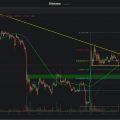Bitcoin has been trading in its current range for more thantwo months, testing from time to time the upper ($10,400) and lower ($8,600) boundaries. Considering that all this time traders continued to place positions in anticipation of a breakout of the range and the next macro move, it is natural to expect that at this stage both bulls and bears were largely caught in their positions. The longer the range, the more traders enter positions within it, and the more explosive the move outside of it will be when it finally occurs, because one side will be forced to take losses by closing positions and increasing pressure on the price in the direction of the breakout.
The range itself is problematicsituation for most analysts interested in long-term trends. The nature of trading ranges is such that both bullish and bearish signals within them tend to be invalid. We've seen this happen with both a break below the implied trendline and a failed break of the $9,400 level. From these two setups alone, one can, firstly, assume that both sides were caught by the market in their positions, and, secondly, conclude that signals in this range, as a rule, will be inaccurate and not very useful to predict the direction of the next major move. This is nothing unusual for trading ranges, but it certainly does not add clarity to the current situation.
One of the significant factors contributing tosuch uncertainty in the market is a giant candlestick from the top of the range to the bottom, drawn in early June. All subsequent bars are still within the range specified by it.


Although trends can form within suchranges, their significance is weakened until the price breaks out of the range in one direction or another. The price is in the truest sense of the word squeezed within the range. Until a strong breakout and close outside any of its boundaries occurs, price tends to fluctuate between the two, trapping both bears and bulls over and over again, building up explosive power for the ultimate breakout.
Within a given range, a local downtrend has formed, characterized by successive lower highs (LH) and lower lows (LL):


Although such a local downtrendtestifies to selling pressure, only the final resolution of the range will bring full clarity to market participants. Local trends that emerge within the range simply cannot be trusted as much as trends that unfold outside of it — they should be treated with suspicion. This local downtrend can also easily transition into a local uptrend and test the upper end of the range, not necessarily with any significant breakout.
After crossing up in early June, the EMA 100 and200 continues to serve as price support, fluctuating between $8,947 and $8,658. This level remains key to protect the lower end of the range. If there is a close below the EMA and the lower boundary, all longs opened within the range will be at a significant loss and face a very unfavorable outlook. Likewise, a strong close above the upper line will put short positions under enormous pressure.
Standby range
As long as the price stays inside thisrange, any transactions in this market will be unreliable and redundant. Instead of opening a position early in an attempt to predict the upcoming movement, it would be wiser to wait for a confident breakout of any of its boundaries and try to ride the developing trend from that point, having received more confirmation and with a higher level of confidence.
Bullish scenario
Taking the last local maximum around$9,490 would mark the first higher high of the local trend, suggesting the possibility of another test of the upper end of the range. Depending on the strength, volume and speed of the subsequent movement, it will be possible to draw some further conclusions.
A final break of $10,500 would bean excellent signal to enter a long position, since by this point the price will not only break out of the range, but will also set several successive higher highs. The dynamics that arise when this level is broken will look something like this:
- traders who open short positions within the range will be forced to exit;
- traders who are now waiting in the flat will open longs expecting the continuation of the macro trend;
- current bears will potentially not only close unprofitable short positions, but also open long positions - that is, buy twice, further increasing the upward pressure on the price.
At this point, demand will significantly exceed supply, which will lead to a sharp jump in trading volume and the beginning of a new uptrend for the rest of the year, and possibly longer.
Bear script
A price movement below $8,827 would meanthe formation of another lower low in this local downtrend. As bearish momentum builds as the local downtrend continues, this could set the stage for a potential breakout of the range lower at $8,600. The relative proximity of both lows can further enhance this momentum, leading to a cascading downward move.
This move below $8,600 could takecatastrophic proportions, as buyers will panic close positions opened within the current range. And in the same way, traders waiting in the flat could take advantage of this situation to open a short position, concluding that a retest of previous, lower levels is required for the subsequent final capture of the key level of $10,500.
Range in range in range
Although all the secondary ones I have designated herelevels could be used to enter the market, I would refrain from that. Until the price gets out of range, the risk of being trapped in a noisy market is too high. At the moment, the task is solely to observe the interaction of the price with these internal levels and accumulate information arising from the formation of setups within the main range.


As for the question of whether we are instage of disbelief before the start of the next bullish rally or this is a maximum followed by further consolidation, then we will receive an answer to it only when the price breaks out of any of the boundaries of the main range.
Correlation with traditional markets
One of the most alarming signals of the lattertime is a close correlation of the bitcoin rate with traditional markets. Several times in recent weeks, bitcoin has reacted immediately to significant declines in the Dow or SPX with a drop - like on July 9:


It is reasonable to assume that in the near future,if traditional markets fall, then bitcoin will follow. The key question here is whether we will see a significant second wave of Covid-related restrictions and their potential impact on economic activity around the world. From the point of view of technical analysis, there is every reason to assume that traditional markets are likely to continue to decline: the key resistance is being worked out clearly, and the current rise also does not give the impression of a natural and stable movement:


It should be borne in mind that the technicalanalyzing traditional markets is a thankless task because the endless printing of money makes markets manipulated in every possible way. Therefore, I would not attach much importance to the movements of these markets, however, I remain open to the fact that a sudden collapse in them will have negative consequences for the crypto market.
Altcoins
All over the world altcoins in recent weeksrightly attracted the most attention due to the fall in the BTC dominance index. Personally, I am very wary of alts at this stage, because Bitcoin, as has happened more than once, can interrupt all these positive movements in mid-sentence and, most likely, this will happen. In this sense, it does not even matter in which direction the current BTC range is broken - the movement will be strong, and in most cases turbulent movements lead to the fact that the holders of altcoins sell off their positions, which leads to a decline and continued consolidation in all alt markets. However, such a scenario can serve as a source of valuable information about the current state of the market, from which further conclusions can be drawn.
Conclusion
Bitcoin continues to trade in a range, and up toAs long as the price remains there, I recommend being careful and taking any emerging signals with a fair amount of doubt. In all cases, except for taking the $10,500 level, the development of a bearish scenario with further consolidation seems more likely. Bitcoin's turbulence in any direction will almost certainly hit alts, so I would recommend being patient and taking your time buying them. We should not forget about the impact on the Bitcoin price of sharp movements in traditional markets.
My advice is not to lose patience and just watch how the situation develops for now.
</p>




